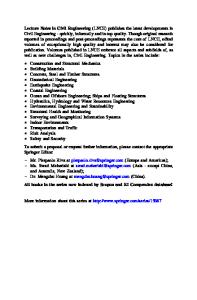Mechanical Properties of Graphene Nanowiggles
- PDF / 4,730,242 Bytes
- 5 Pages / 612 x 792 pts (letter) Page_size
- 54 Downloads / 375 Views
Mechanical Properties of Graphene Nanowiggles R. A. Bizao, T. Botari and D. S. Galvao Applied Physics Department, State University of Campinas, 13083-970, Campinas-SP, Brazil ABSTRACT In this work we have investigated the mechanical properties and fracture patterns of some graphene nanowiggles (GNWs). Graphene nanoribbons are finite graphene segments with a large aspect ratio, while GNWs are nonaligned periodic repetitions of graphene nanoribbons. We have carried out fully atomistic molecular dynamics simulations using a reactive force field (ReaxFF), as implemented in the LAMPPS (Large-scale Atomic/Molecular Massively Parallel Simulator) code. Our results showed that the GNW fracture patterns are strongly dependent on the nanoribbon topology and present an interesting behavior, since some narrow sheets have larger ultimate failure strain values. This can be explained by the fact that narrow nanoribbons have more angular freedom when compared to wider ones, which can create a more efficient way to accumulate and to dissipate strain/stress. We have also observed the formation of linear atomic chains (LACs) and some structural defect reconstructions during the material rupture. The reported graphene failure patterns, where zigzag/armchair edge terminated graphene structures are fractured along armchair/zigzag lines, were not observed in the GNW analyzed cases. INTRODUCTION The advent of graphene [1] opened a new era in materials science. Graphene has unique electronic, optical and mechanical properties [2]. Because of these exceptional properties, graphene is considered as the basis for a new nanoelectronics. However, graphene is a zero bandgap semiconductor in its pristine form, which poses limitations to its use in some kind of transistors. One possible way to open the graphene gap is to create graphene nanoribbons [3,4]. Graphene nanoribbons are finite graphene segments with a large aspect ratio. Recently, a new family of nanoribbons, called graphene nanowiggles (GNWs) [5] has been object of many experimental and theoretical investigations [6,7]. GNWs are nonaligned periodic repetitions of graphene nanoribbons as can be seen on Figure 1(a). In Figure 1(b-d) GNW structures are shown in yellow and the ‘cut’ region to form a GNW from a graphene sheet is shown in red. GNWs were synthetized by a recently bottom-up technique, which allows a precise control of the generated structure, instead of the more standard synthesis techniques, such as, chemical or lithographic methods [5], where fine control is difficult to achieve. One of the ways to uniquely characterize the GNW geometry is through the definition of four structural parameters: Pα, Oβ, LP and Lo. The α and β indices can have A or Z values, depending on whether the segment if armchair (A) or a zigzag (Z) one. The Pα and Oβ parameters characterize the GNW segment width by the number of C-C dimer lines (α or β = A), or by zigzag stripes (α or β = Z), for parallel (Pα) and oblique (Oβ) segments, respectively [7]. In this sense, there are four possible combinations of
Data Loading...











